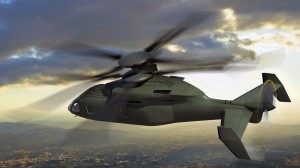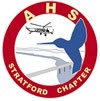 Sikorsky Aircraft and Boeing are jointly producing a medium-lift-sized demonstrator they call SB>1 Defiant for phase one of the program. It will fly in 2017 and will be evaluated by the Army for further development. Sikorsky is leading the development of phase one with an aircraft based on their previous Sikorsky X2 design.Compared to conventional helicopters, the counter-rotating coaxial main rotors and pusher propeller offer a 185 km/h (115 mph) speed increase, combat radius extended by 60%, and performs 50% better in high-hot hover performance. Boeing plans to lead phase two, which is the mission systems demonstrator phase.The Boeing-Sikorsky team is seen to have an advantage, given their industrial base, the fact that their helicopter designs are the most used in the Army, and because the Army has had little interest in tiltrotor technology, like that submitted by Bell. The design will have a cruise speed of 250 kn (290 mph; 460 km/h), but less range due to using the “old” T55 engine. A new engine (the future affordable turbine engine (FATE) like on the V-280) would meet the range requirement of 229 NM (264 mi; 424 km). Sikorsky has said that the X2 design is not suitable for heavy-lift size, and instead suggests the CH-53K for heavy-lift and tiltrotor for the ultra-class. However, Sikorsky plans to build the 30,000lb-class JMR-TD at full scale to remove doubts about the scalability of the X-2 technology. The team feels confident in the SB-1 Defiant and is paying for more than half of its design costs. The SB-1 will be quick and nimble, with fast acceleration and deceleration, side-to-side movement, and hovering with the tail up and nose down.The Defiant demonstrator will be powered by the Honeywell T55, which powers the CH-47 Chinook. It will be slightly modified to better operate at slower speeds.
Sikorsky Aircraft and Boeing are jointly producing a medium-lift-sized demonstrator they call SB>1 Defiant for phase one of the program. It will fly in 2017 and will be evaluated by the Army for further development. Sikorsky is leading the development of phase one with an aircraft based on their previous Sikorsky X2 design.Compared to conventional helicopters, the counter-rotating coaxial main rotors and pusher propeller offer a 185 km/h (115 mph) speed increase, combat radius extended by 60%, and performs 50% better in high-hot hover performance. Boeing plans to lead phase two, which is the mission systems demonstrator phase.The Boeing-Sikorsky team is seen to have an advantage, given their industrial base, the fact that their helicopter designs are the most used in the Army, and because the Army has had little interest in tiltrotor technology, like that submitted by Bell. The design will have a cruise speed of 250 kn (290 mph; 460 km/h), but less range due to using the “old” T55 engine. A new engine (the future affordable turbine engine (FATE) like on the V-280) would meet the range requirement of 229 NM (264 mi; 424 km). Sikorsky has said that the X2 design is not suitable for heavy-lift size, and instead suggests the CH-53K for heavy-lift and tiltrotor for the ultra-class. However, Sikorsky plans to build the 30,000lb-class JMR-TD at full scale to remove doubts about the scalability of the X-2 technology. The team feels confident in the SB-1 Defiant and is paying for more than half of its design costs. The SB-1 will be quick and nimble, with fast acceleration and deceleration, side-to-side movement, and hovering with the tail up and nose down.The Defiant demonstrator will be powered by the Honeywell T55, which powers the CH-47 Chinook. It will be slightly modified to better operate at slower speeds.
